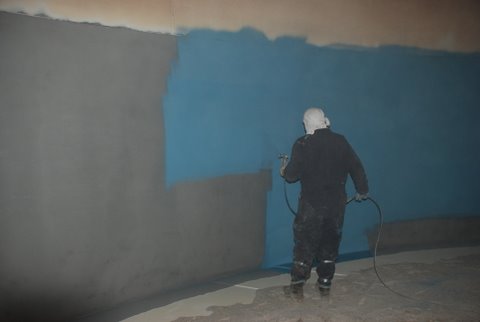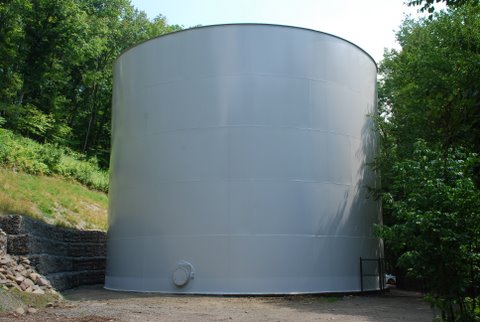Tank coatings and trout fishing? Two worlds that must be kept separate – at least until the work day is over. But what happens when the work day and the fishing hole collide? Well, not exactly collide…but more accurately are separated by a distance of 30 feet (9.14m). As Tex Enoch, water market manager for Induron Protective Coatings, who was the coatings rep on-site says, “The 750,000 gallon (2,839,059L) ground storage potable water tank is located on Mill Creek, one of the most famous fresh water trout streams in Pennsylvania.”
Contractor, Kent Webster of Corrosion Control Corporation, continues, “There was a trout breeding stream immediately next to the tank. From the beginning, even before we knew about the lead, we knew containment would be an issue.” Lead? Whether the subject is fish or coatings, that’s a word nobody likes to hear.
Environmental concerns. Health concerns. As the story of this job unfolded and more undiscovered problems arose, it sounded less like an average coatings project, and more like a “fish tale.” Ironically, this project would be one for the record books, and all based on fact, not fiction.
A River Runs Near It – So No Polluting
“The steel tank itself hadn’t been painted in 27 years,” explains Enoch. “The interior was pitted and had isolated areas of rust. The outside had surface rust.” But there was a mix-up with the initial project specifications.
“When we started the project, we didn’t know that the coatings contained lead,” says Webster. “Actually initial testing said that the interior coatings contained lead, and the outside did not. But since this is a potable water tank, I thought that must have been a mistake.”
 Confirming his suspicions, Webster ran his own tests. “Sure enough, there had been a mix-up and the report was wrong. The inside coatings were clean. The outside coatings contained trace amounts of lead,” he says. This meant that their containment now had to account for lead – the crew had to adjust their PPE to be lead-sensitive and “lead dust certainly couldn’t reach the trout breeding stream.”
Confirming his suspicions, Webster ran his own tests. “Sure enough, there had been a mix-up and the report was wrong. The inside coatings were clean. The outside coatings contained trace amounts of lead,” he says. This meant that their containment now had to account for lead – the crew had to adjust their PPE to be lead-sensitive and “lead dust certainly couldn’t reach the trout breeding stream.”
The Corrosion Control crew is used to working in lead remediation situations. Webster describes the situation: “The crew had their blood (lead) levels monitored before and after the job, wore full PPE including Tyvek suits, respirators, gloves, and goggles, we established a makeshift changing trailer and had strict break rules – there was no eating or drinking allowed in the area.”
But as for the containment which had to be in place during the coatings removal process -- that could not be as complete because of the job site itself. Bracketed by a trout stream on one side, the tank was literally cut into the side of a bank on the other. “We couldn’t build a total containment system because the tank was built into a bank that cut about four feet into the base of the tank itself,” Webster says. “It precluded us from putting up a traditional scaffold system.”
Instead, using scaffolding and canvas, the crew devised a mini revolving system that allowed them to abrasive blast clean in approximately 60-feet-high by 16-feet-wide (18.29m x 4.88m) sections. “Ordinarily we would have wanted total containment,” Enoch concurs. “But we couldn’t. So this was the next best solution.” Using scaffolding and canvas, the crew also built a permanent containment bonnet for the top of the tank. At least they didn’t have to contend with removing antennas because there weren’t any on this tank.
Casting Off -- Starting Coating
Containment in place, it was time to “cut bait or fish.” But just when it seemed the problems had been resolved, Mother Nature decided to intervene. Spring time in Pennsylvania can be wet, and the spring of 2009 was an especially wet one. “The job started in April,” Enoch says, “and stretched out over three months due in large part to weather delays.” Fortunately, the specifications had taken the weather into account and the crew could work on the tank interior when the exterior conditions became too extreme.
 “First, they blasted the tank using Black Beauty,” states Enoch. “The specs called for a minimum angular surface profile of 2 mils (0.051mm) on the exterior and 3 mils (0.076mm) on the interior. They cleaned the exterior to NACE No. 3/SSPC-SP-6 Commercial and the interior to NACE No. 2/SSPC-SP-10 Near-White Metal. Blasting concurrently, it was a 30 day process.”
“First, they blasted the tank using Black Beauty,” states Enoch. “The specs called for a minimum angular surface profile of 2 mils (0.051mm) on the exterior and 3 mils (0.076mm) on the interior. They cleaned the exterior to NACE No. 3/SSPC-SP-6 Commercial and the interior to NACE No. 2/SSPC-SP-10 Near-White Metal. Blasting concurrently, it was a 30 day process.”
“We had an IPEC 20,000 cfm dust collector hooked up while we were blasting,” explains Webster, “So none of the dust escaped from the containment system.”
To apply the exterior coating system, the crew used brushes and rollers because, “nobody wanted to risk the slightest chance of overspray reaching the trout stream,” Enoch says. For the prime coat on the exterior, the crew applied Induron’s PE-70, a 70 percent solids polyamide epoxy to a DFT of 3 to 5 mils (0.076 to 0.013mm). This was followed by an intermediate coat of Induraguard Semi-Gloss SG 75 percent solids epoxy, which was roller- and brush-applied to a DFT of 3 to 5 mils (0.076 to 0.013mm). The top coat was Indurathane polyurethane, a 70 percent solids polyurethane, which was also applied by roller and brush to a DFT of 3 to 5 mils (0.076 to 0.013mm).
The interior received a single coat of Induron’s Permaclean 100 ceramic epoxy. “The 100 percent solids coating was applied to a minimum DFT of 25 mils (0.635mm),” Enoch explains. “Permaclean 100 carries NSF approval for up to 50 mils (1.27mm). The coatings itself contains various sizes of microscopic ceramic beads and they form a phenomenal water barrier.”
He continues, “After the Corrosion Control Crew spray applied a single coat of Permaclean 100 to the entire interior surface of the tank at the required minimum DFT of 25 mils, they then stripe coated all the interior weld seams, angles joints and pitted areas. They were able to do this because Permaclean 100 has a 30 day recoat window. The tank was then completely tested for holidays using a high voltage holiday detector and none were found.”
That meant that three days later, the 750,000 gallon (2,839,059L) tank was filled and back in service. And the coatings crew? Were they to be found relaxing at the trout stream? No. They were off to their next job. But this is one “fish story” that really is true. Mother Nature and a whopper of a tank -- both protected by coatings ingenuity.